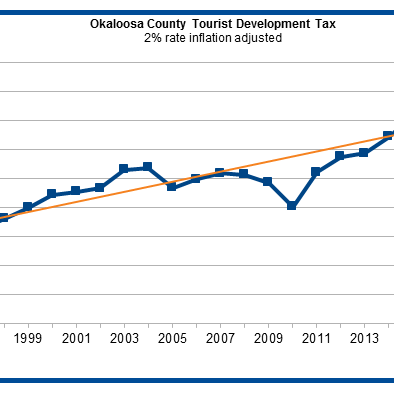A Brief Look at Northwest Florida Tourism
Haas Center | May 20, 2019
We recently took a look at the tourist development tax collections for five of the counties in Northwest Florida. In addition to normalizing the collection rate so that different periods of time could be compared to each other, we also adjusted the dollar value of the collections to account for inflation. By doing this, we can better examine the volume of visitors to the area over time. We also looked at the changes in the available numbers of rental units and the revenues they generate. Here are the results using 2018$.
Escambia County tourism revenues were on the rise before two hurricanes, an oil spill and a recession took their toll. It has taken 10 years for collections to return to the trend path that they were on before these events but they have increased significantly since then. <strong bed tax revenues doubled between 2004 and 2018, while licensed available rental units increased from 8,853 in 2004 to 9,729 in 2018. Annual revenues per unit have also increased from an inflation adjusted $18,516 in 2004 to $30,748 in 2018.

Santa Rosa County tourism shows a different pattern. It was growing more rapidly than Escambia before the hurricanes but took longer to recover after. Rental unit revenues grew 133% between 2003 and 2018, while the number of available rental units has recovered to near pre-hurricane levels. There were 1,463 available units in 2003, generating $21,723 in 2018 dollars per year on average. In 2018, there were 1,416 licensed units that generated an average of $48,227 per unit annually.
Okaloosa County was not impacted as severely from Hurricanes Ivan and Dennis, although its bed tax revenues did decrease somewhat. It was not until the recession and oil spill that these collections dropped significantly and Okaloosa has now returned to trend and is growing. There were 13,605 available licensed units in 2005, generating $17,223 in 2018 dollars per year on average. In 2017, there were 12,138 licensed units that generated an average of $33,110 per unit annually.
Walton County has displayed the most stable growth pattern in its tourist revenue collections, although it also did not escape the Great Recession. Tourism there recovered at roughly the same time as it did for the rest of the Emerald Coast. One striking difference is average revenue per licensed unit. While the other locations have seen increases, Walton County had 6,511 licensed units that generated average inflation adjusted revenues per unit of $42,877 in 2005. By 2018, it had 8,899 licensed units that generated $37,417.
Bay County, before Hurricane Michael, had many years of stable tourism revenues. While declining somewhat during the Great Recession, collections rebounded fairly quickly and were increasing quickly before the storm. Bay County had 13,155 licensed units that generated average inflation adjusted revenues per unit of $17,002 in 2005. By 2017, it had 17,262 licensed units that generated $27,599. The horrific damage to Bay County’s tourism infrastructure will be affecting their bed tax revenue collections for the foreseeable future as rebuilding occurs. What takes the place of the damaged infrastructure is also likely to affect room revenue rates which will also impact tax collections.


